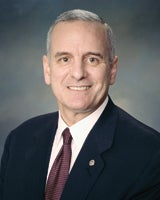Legislature returns to budget battle lines with lots to do
Published 9:51 am Tuesday, April 7, 2015
ST. PAUL (AP) — Minnesota’s legislative session is moving into the Choose Your Own Adventure phase as lawmakers return from their spring break.
When lawmakers reconvene Tuesday, the split-power Legislature and Democratic Gov. Mark Dayton will have 42 days to decide which path to take to craft a state budget for the next two years totaling more than $40 billion. Should they adopt deep tax cuts? Hike payments to schools? Stash extra money away for a rainy day?
Lawmakers are also at a crossroads on transportation spending, a nagging problem with vastly different options on the table.
The state has a $1.9 billion projected surplus, but that may not make the decisions easier — especially if lawmakers or the governor embrace the stand-firm politics that have led Minnesota into government shutdowns before.
Here’s where things stand:
What needs to happen
Lawmakers started the 2015 session with vastly different ideas, but one imperative: Set a new two-year-budget.
Republicans, who gained control the House last fall, want to limit spending and cut taxes. Dayton and his fellow Democrats, who control the Senate, say the surplus gives Minnesota room to stage for the future by investing heavily in education.
Dayton is the only one to put forward a full budget plan so far. The House and Senate will spend April staking out their proposals.
At a minimum, lawmakers must approve funding for state agencies — such as the Department of Revenue, which handles taxes, or the Department of Natural Resources, which employs the rangers who watch over Minnesota’s state parks.
What if they can’t agree?
The centerpiece for House Republicans is a push for $2 billion in tax cuts, though they’ve given few specifics about whose taxes could be cut. The governor and Democrats have their eye on substantial funding boosts for education, including preschool programs and expanding financial aid for college.
Each side needs support from the other, so there’s incentive for good-faith bargaining.
However, the Legislature isn’t required to pass a tax bill, which sets rates and determines credits and deductions for years to come. Lawmakers also don’t have to allocate new spending for K-12 education.
If neither issue is addressed, tax rates and school spending would remain at current levels. That would leave much, if not all, of the projected surplus unallocated, essentially leaving it to fight over next year.
But lawmakers can’t dodge when it comes to bills authorizing spending for the basic operation of state agencies because doing so would thrust Minnesota into its third partial government shutdown in the last decade.
Bargaining chips
Democrats and Republicans have a bevy of proposals on the table that could be used as trade-offs to secure a better deal in budget negotiations.
For example, House Republicans are advancing bills that would never make it through the Democratic-controlled Senate, such as proposed abortion restrictions or repealing MNsure, the state’s health insurance exchange. Republicans also have suggested shuttering the public health program MinnesotaCare, which could save more than $900 million but would move about 95,000 low-income residents to MNsure or the federal health insurance exchange.
In the Senate, Democrats are pressuring for a statewide paid sick-leave program and a transportation funding plan based on tax hikes, neither of which are supported by Republicans. The GOP favors tapping the budget surplus and rerouting existing tax revenue for roads and bridges.
Each side has moved forward on those proposals, which could be cast off last-minute to get concessions from the other side.






